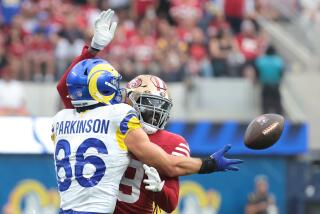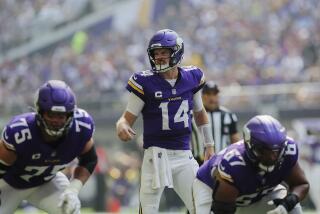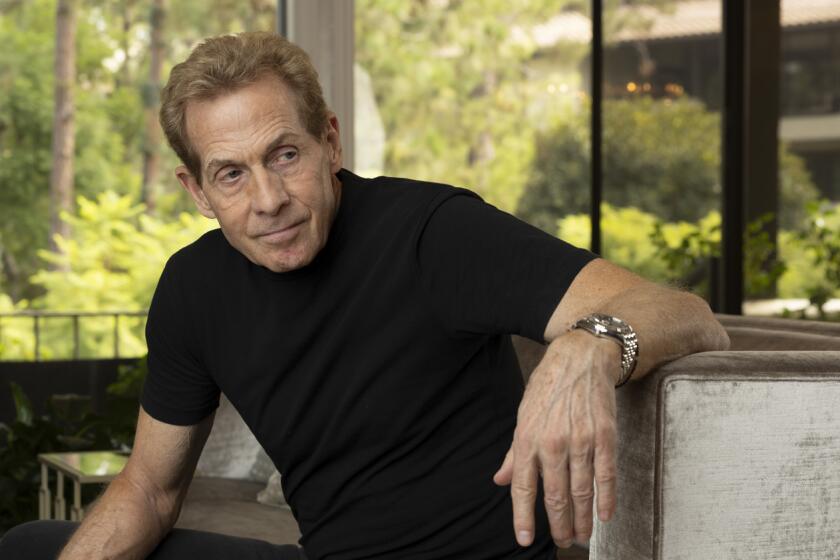49ers coach reshaped football
Bill Walsh, known in football circles as “The Genius” for taking his San Francisco 49ers to three NFL championships and designing the “West Coast offense” that has countless devotees in both college and professional ranks, died Monday. He was 75.
Diagnosed with leukemia in 2004, Walsh had been in failing health for several months and died at his home in Woodside, Calif., according to Stanford University, where he had been a coach and athletic director.
Cerebral, introspective and innovative, Walsh had an uncanny eye for scouting players and designing refined game plans. His offensive scheme -- predicated on short passes that depended on timing -- fueled a dynasty in San Francisco with Super Bowl victories after the 1981, ’84 and ’88 seasons.
George Seifert, Walsh’s defensive coordinator, who retained the same offensive system after Walsh retired, led the 49ers to two more Super Bowl victories after the 1989 and 1994 seasons.
John Madden, the Hall of Fame coach and longtime NFL broadcaster and analyst, said Monday that “Bill’s legacy is going to be that he changed offense. Offense before Bill Walsh was run, run defense, establish the run. Run on first down, run on second down, and if that doesn’t work, pass on third down. Bill Walsh passed on first down, passed on second down and used that to set up the run.
“People use the word genius and we usually scoff at that. In his case, I don’t think you can scoff at it.”
And the Hall of Fame quarterback Joe Montana, the player most closely associated with Walsh’s tenure with the 49ers, told the Associated Press: “This is just a tremendous loss for all of us, especially to the Bay Area, because of what he meant to the 49ers. For me personally, outside of my dad he was probably the most influential person in my life. I am going to miss him.”
Instantly identifiable on the sidelines with a shock of white hair under his headset, Walsh amassed a remarkably consistent record as an NFL coach. His 49ers were the winningest franchise of the 1980s, with only two losing seasons in the decade: 6-10 in 1980 and 3-6 in the strike-shortened 1982 season. Even more astounding was that, in 1978, he took over a rudderless club, a perennial doormat that had won only two games the previous season.
“The one thing that sticks in my mind about playing for Bill was how unfair it was, because we had such an advantage over the people we were playing,” said Randy Cross, a mainstay on the offensive line throughout Walsh’s coaching career in San Francisco. “Not everyone wanted to admit that. Some people had to come around to it grudgingly.”
Not a screamer
Unlike many in his profession, Walsh wasn’t a wild-eyed screamer like Green Bay’s legendary Vince Lombardi, who struck fear in the hearts of his players. Instead, he was almost scholarly, and at times plagued with self-doubt. Jim Murray, the late Times sports columnist, wrote that Walsh “baffles longtime coach-watchers. He is least coach-like of anyone in the profession. He could be anything from an Elizabethan poetry teacher to an opera critic.”
Walsh was fully aware that he did not fit the standard NFL mold.
“I know there were coaches who were certainly more intelligent than I was,” he told The Times in December. “There were firebrand coaches who fired up their teams and all that kind of thing. But we basically understated everything publicly. We never talked about, ‘We’re going to the Super Bowl,’ or, ‘We’re the best; come and get us,’ all that kind of thing. We just quietly went about our business, and I do think people resented that. They wanted confrontation, and they didn’t get it until we played.”
Walsh retired from the National Football League in 1989, after leading his 49ers to victory over Cincinnati in Super Bowl XXIII. In doing so, he joined Lombardi as the only other NFL coach to step down immediately after winning a Super Bowl.
William Ernest Walsh was born Nov. 30, 1931, in Los Angeles. It was the height of the Depression, and Walsh’s father worked as a day laborer on a series of difficult and low-paying jobs.
His family moved around a bit, and Walsh graduated from Hayward High School in the East Bay. A left-hander, he played quarterback and participated in track and field.
Although he had hoped to attend UC Berkeley or Stanford on a football scholarship, he had neither the grades nor the athletic ability for admittance. He played two seasons at San Mateo Junior College before transferring to San Jose State. He switched positions when he got there, playing offensive and defensive end for the Spartans.
He was never approached to play pro football but was determined to stay in the game. He took a job as a graduate assistant under San Jose State Coach Bob Bronzan and immediately excelled.
“I went into coaching with the resolve that my coaching career wouldn’t be a disappointment to me,” Walsh once told the Saturday Evening Post. “So I worked doubly hard at it.”
It was at Washington Union High School in Fremont, Calif., that Walsh got his first job as head coach. There, in two years, he transformed a team that had lost 26 of 27 games into a 9-1 powerhouse. That led to assistant-coaching jobs at UC Berkeley and Stanford over the next five years.
In 1966, Walsh got his introduction to pro football when the Oakland Raiders hired him as a backfield coach. He often questioned his decision to leave Stanford but said he was “attracted to the technical, artistic part of the pro game.”
He moved to the Cincinnati Bengals in 1968, where he stayed through 1975 and built a reputation as an elite quarterback coach under the legendary Paul Brown. Although Walsh and Brown were cordial, they were neither close nor did they share the same football philosophies. So when Brown retired in 1975, he appointed another assistant, Bill “Tiger” Johnson, rather than Walsh as his replacement.
“The way it was done was not as civilized as it should have been,” Walsh said. Brown “didn’t tell me. The TV people came to my house and told me. So that wasn’t very good.
“We really loved Cincinnati. We enjoyed it thoroughly, and our kids were in school, and we had good friends. But the minute that happened, my wife and I knew that we’d have to leave and go someplace to start over. And we did.”
The Walshes left for Southern California, where he took a job as offensive coordinator of the San Diego Chargers. He spent less than a year there before accepting the position of head coach at Stanford, where in two seasons he turned around an average program with victories in the 1977 Sun Bowl and 1978 Bluebonnet Bowl.
In nearby San Francisco, the 49ers had hired and fired four coaches in two years. Eddie DeBartolo, who at 33 had owned the team for three years, was looking to make his mark by turning around a losing franchise. In 1979, he hired the 47-year-old Walsh as coach and general manager.
It took three seasons for Walsh to transform the 49ers from one of the league’s worst teams to one of its best. Although San Francisco went 2-14 in 1979, matching its record from the previous season, the seeds of victory were sown. Walsh used a third-round pick in 1979 to select Notre Dame’s Joe Montana, who would go on to win four Super Bowls, three league MVP awards and establish himself as one of the best quarterbacks in NFL history.
Montana didn’t play his rookie season, and only became the starter late in his second year. It was that season when he steered the 49ers to a 28-point, record-setting comeback in a 38-35 victory over the New Orleans Saints. The 49ers finished 6-10, but their confidence was beginning to grow.
“I think from that point on, we were never out of a game in our minds,” Cross said. “You’ve got to do something like that in order to believe as much as we did.”
Walsh’s offensive plan, which came to be known as the West Coast offense, relied on a greater variety of short passes than any other team. In his system, passes were almost like long handoffs. The running backs had to be able to catch, and the quarterbacks had to be able to scramble. The tight end was a receiver more than a blocker, and the wide receivers frequently ran crossing patterns.
Longtime Bay Area sports columnist Lowell Cohn, whose 1994 book “Rough Magic” examined Walsh’s 1992 return to Stanford, once wrote that the coach had an unquenchable “fervor to invent.” Cohn recalled a story about Walsh working at UC Berkeley under Coach Marv Levy, who held staff meetings in a room with three blackboards.
Cohn said that Walsh “would scribble a play furiously in any available space but, before he finished, his mind would skip to another play. He would move to the next board and start writing, while he’d still be talking about the first play. Levy used to follow Walsh around the room with an eraser and rub out the plays because the other coaches were getting confused.”
Sam Wyche, one of his quarterbacks in Cincinnati and a future NFL coach, said it wasn’t uncommon for Walsh to draw up plays on a napkin and use them with spectacular success on Sundays.
At the time, Wyche estimated that 20% of the Bengals’ plays were “brand-new, never-before-used plays that we put in the week before. Fifty percent of what we will use in a game won’t appear in the films opponents use to study us. That’s how much we switch during a season.”
Breakthrough year
Walsh’s ideas were not entirely original. Most of them were variations on the schemes devised by Sid Gillman, a Hall of Fame coach for the Los Angeles Rams and the Los Angeles and San Diego Chargers who was widely credited with revolutionizing the passing game. Walsh learned them during his stint with the Raiders from owner Al Davis, who had worked with Gillman.
The first real payoff came in the 1981 season, when the 49ers finished a league-best 13-3 and Montana led the National Football Conference in passing. Then, in one of the most memorable moments in NFL history, the 49ers beat the Dallas Cowboys in the conference title game on a late touchdown pass from Montana to Dwight Clark. The leaping grab became known in NFL lore as “The Catch” and propelled the 49ers to their first Super Bowl.
In what became the ultimate vindication for Walsh, his team faced and defeated the Bengals, who had Brown as general manager, the man who denied him a head coaching opportunity in Cincinnati. The media hailed Walsh as a genius, but he dismissed that as typical hyperbole.
The 49ers took a step back the following season. Distracted by the Super Bowl afterglow, drug problems and a deteriorating pass defense, they went 3-6 in a season abbreviated by a players strike. That disappointment led to Walsh being stripped of his general manager role and almost caused him to resign. DeBartolo talked him out of that, however, giving him the title of team president to go along with his job as coach.
The 49ers didn’t stay down long. In 1984, they finished 15-1 and beat the Chicago Bears in the NFC championship game and the Miami Dolphins in the Super Bowl.
Despite his genius label and aura of invincibility, Walsh had persistent worries about staying on top. He was constantly concerned that opponents were closing the gap, those closest to him recall.
“As self-confident and self-assured as he was, there were moments when he seemed to suffer from nagging and insurmountable insecurity,” said Carmen Policy, former 49ers president. “It was at those times when the people who worked with him, including Eddie, came to his rescue. We could sense when it was developing, and you put everything aside and ran to shore up the genius.”
Policy said the insecurity showed “in the way he handled certain losses, his relentless self-questioning, and at times the constant suggestion that maybe he wasn’t capable of carrying on and maintaining the level he achieved.... The expectations were overbearing. Everyone felt the pressure, but he was the one person where the center of gravity rested.”
At times, that insecurity would permeate the organization. Walsh harnessed that and used it to inspire his players.
Keeping his focus
“If Bill was going to make an error, it was going to be on the side of letting guys go too early instead of too late,” former 49ers tight end Brent Jones said. “That made for a little bit of insecurity in the locker room, and it drove guys to be their best.”
Walsh said he always kept in focus his primary objective, which was fielding the best possible team regardless of the personal relationships he had with players.
“So maybe it was a little less difficult for me to change personnel than it might have been for other coaches,” he said. “In a sense we were able to maintain or prevail or even improve ourselves as years went by going through that process that in each instance was very difficult.”
Along with his superior skill at mapping offensive game plans, Walsh had a legendary eye for talent. Perhaps his best draft maneuver came in 1985, when he exchanged picks with New England to move up in the first round and select Mississippi Valley State’s Jerry Rice, who went on to become football’s greatest receiver.
The 49ers were competitive in 1985 and ’86 but failed to win conference championships. In 1987, despite a 13-2 record in another strike-shortened season, they were stunned by the Minnesota Vikings in a first-round playoff game at Candlestick Park. As a result, DeBartolo took away Walsh’s title as club president.
San Francisco rebounded in the 1988 season, reaching the Super Bowl for a third time, against Cincinnati. The game was supposed to be high-scoring but instead was a defensive battle. The 49ers won, 20-16.
Worn down by the pressures of coaching, Walsh retired after that season with three Super Bowl victories, putting him right behind Pittsburgh’s legendary Coach Chuck Noll, who won four, and even with Joe Gibbs of Washington. Of the current crop of top coaches, Bill Belichick has won three with New England.
After leaving the 49ers, Walsh accepted a job as a game analyst for NBC but returned to college coaching at Stanford in 1992. He went 10-3 in his first season and beat Penn State in the Blockbuster Bowl but dipped to 4-7 the next year and 3-7-1 in 1994. Then, it was back to the 49ers for roles as general manager and, eventually, team consultant.
By then, the league was filled with coaching protegees who either had worked for him directly or emulated his offensive schemes. Among them are current NFL coaches Brian Billick of the Baltimore Ravens, Jon Gruden of the Tampa Bay Buccaneers, Mike Holmgren of the Seattle Seahawks, Gary Kubiak of the Houston Texans and Mike Shanahan of the Denver Broncos.
“Bill could have run Google or Microsoft,” Jones said. “He wasn’t happy with good, or very good. It had to be excellent at all times. He did that in his approach to coaching, his design of plays, his personnel, everything.”
Survivors include his wife, Geri, son Craig and daughter Elizabeth. Walsh’s son, Steve, an ABC News reporter, died of leukemia at age 46 in 2002.
--
(BEGIN TEXT OF INFOBOX)
Walsh’s winning ways
Bill Walsh’s San Francisco 49ers record:
*--* Regular Season Playoffs Year W L T W L 1979 2 14 0 1980 6 10 0 1981 13 3 0 3 0 1982 3 6 0 1983 10 6 0 1 1 1984 15 1 0 3 0 1985 10 6 0 0 1 1986 10 5 1 0 1 1987 13 2 0 0 1 1988 10 6 0 3 0 Total 92 59 1 10 4
*--*
More to Read
Go beyond the scoreboard
Get the latest on L.A.'s teams in the daily Sports Report newsletter.
You may occasionally receive promotional content from the Los Angeles Times.











